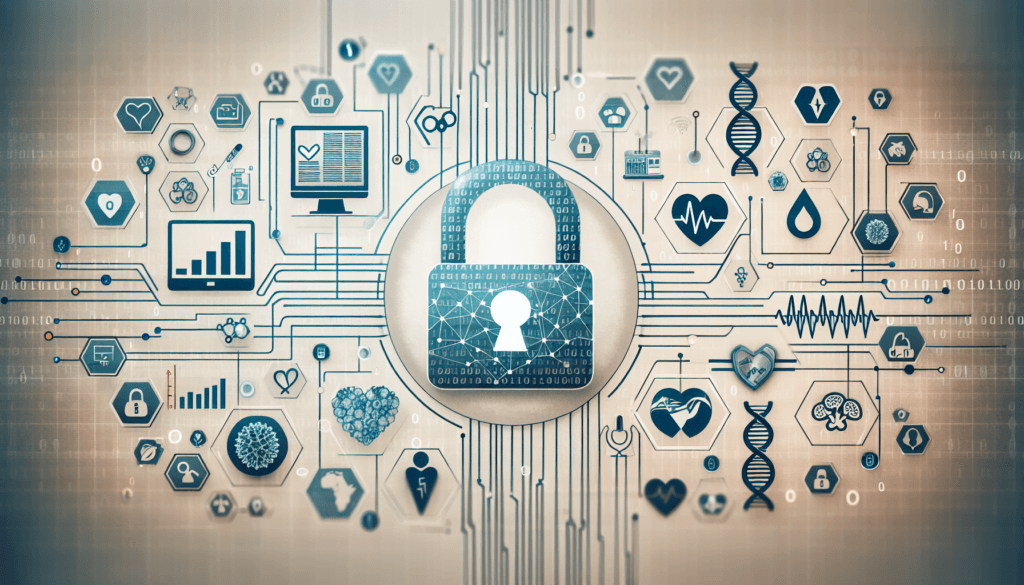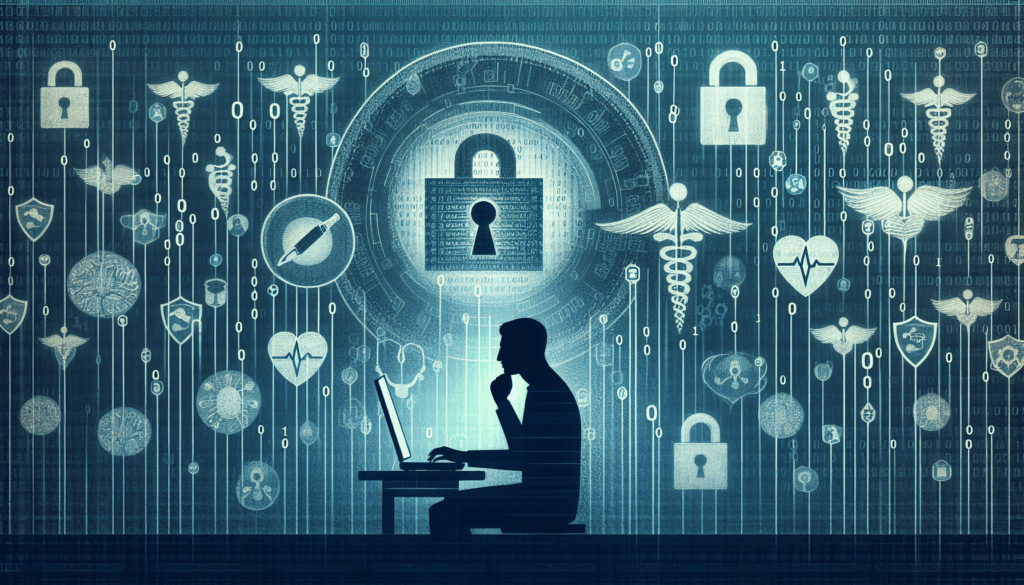In today’s digital age, where personal information is constantly being shared and accessed online, it is crucial to understand how to navigate health information privacy concerns. With the increasing presence of healthcare-related platforms and services, individuals must educate themselves on the potential risks and safeguards associated with sharing sensitive health data. This article aims to provide practical guidance on safeguarding your health information and ensuring its privacy while navigating the vast online landscape. By implementing these strategies, you can protect your personal health data and maintain control over its confidentiality in the digital realm.

Table of Contents
Understanding the importance of health information privacy online
What is health information privacy?
Health information privacy refers to the protection and safeguarding of personal health information when it is shared or accessed online. This includes any data related to an individual’s health, medical history, treatment, or other sensitive information.
Why is health information privacy important?
Health information privacy is crucial for several reasons. First and foremost, it is essential to respect individuals’ right to privacy and maintain confidentiality. Health information is highly personal and sensitive, and unauthorized access or disclosure can lead to significant harm and breach of trust.
Additionally, health information privacy is vital for maintaining the trust between healthcare providers and patients. When individuals feel that their health information is secure and protected, they are more likely to seek medical help and share accurate information, leading to better healthcare outcomes.
The risks of not protecting health information privacy
Failing to protect health information privacy can have severe consequences. The unauthorized disclosure or use of personal health information can result in identity theft, medical identity theft, discrimination, and even financial fraud. Furthermore, it can lead to reputational damage for the individuals affected, as well as the healthcare organizations responsible for safeguarding the information.
Another risk is the potential breach of medical records, which can compromise patient safety and affect the quality of care. Healthcare providers rely on accurate and up-to-date health information to make informed decisions, and any unauthorized access or manipulation of this data can lead to medical errors and detrimental health outcomes.
Identifying potential privacy concerns when seeking health information online
The sources of health information online
When seeking health information online, it is essential to consider the reliability and credibility of the sources. Various websites, blogs, forums, and social media platforms provide health information, but not all of them are trustworthy. It is crucial to rely on reputable sources such as government health websites, academic institutions, and recognized medical organizations to ensure accurate and evidence-based information.
The types of personal health information shared online
Individuals often share personal health information online, either voluntarily or unknowingly. This information can include symptoms, medical conditions, medication usage, and even detailed accounts of personal experiences with healthcare providers. While sharing experiences and seeking support can be beneficial, it is essential to be cautious about the extent of information shared and the platform used.
The risks of sharing personal health information online
Sharing personal health information online can pose significant risks to privacy. It can lead to the exposure of sensitive data to unauthorized individuals, including hackers and scammers. This can result in identity theft, targeted advertising, and even discrimination based on health conditions. Moreover, once information is shared online, it can be challenging to control its dissemination and ensure its accuracy and security.
Protecting health information privacy online
Using secure websites and platforms
One of the fundamental ways to protect health information privacy online is to use secure websites and platforms. Ensure that the websites you visit have HTTPS encryption, which indicates a secure connection. Additionally, consider using platforms with built-in privacy features, such as strong authentication methods and encryption protocols.
Ensuring the website is trustworthy
Before sharing any personal health information online, carefully evaluate the trustworthiness of the website. Look for clear privacy policies that outline how the information will be used and protected. Check for contact information, such as a physical address and phone number, to verify the legitimacy of the website. It is also advisable to read reviews or seek recommendations from reputable sources before relying on a particular website.
Recognizing fake or misleading health information
The internet is rife with misleading or false health information. It is crucial to develop critical thinking skills and be able to recognize red flags of unreliable sources. Look for peer-reviewed references, credentials of authors, and evidence-based claims. Be skeptical of websites or sources that make exaggerated or unfounded claims, lack citations, or have a biased agenda.
Understanding legal rights and regulations regarding health information privacy online
HIPAA and its protections
The Health Insurance Portability and Accountability Act (HIPAA) is a federal law that protects the privacy and security of health information. It establishes safeguards for the use and disclosure of personal health information by healthcare providers, health plans, and healthcare clearinghouses. Under HIPAA, individuals have the right to access and control their health information and can file complaints if they believe their rights have been violated.
Other relevant laws and regulations
In addition to HIPAA, other laws and regulations govern health information privacy. These include state privacy laws, the General Data Protection Regulation (GDPR) in the European Union, and the California Consumer Privacy Act (CCPA). It is essential to be aware of these regulations and understand how they apply to the protection of personal health information online.
Organizations and entities involved in protecting health information privacy
Various organizations and entities are dedicated to protecting health information privacy. These include government agencies, such as the U.S. Department of Health and Human Services’ Office for Civil Rights, which enforces HIPAA regulations. Additionally, non-profit organizations like the Electronic Frontier Foundation educate the public and advocate for privacy rights in the digital age.

Practicing safe online behavior to safeguard health information privacy
Creating strong and unique passwords
Creating strong and unique passwords is crucial for protecting health information privacy. Avoid using obvious or easily guessable passwords and consider using password managers to securely store and generate complex passwords. Regularly update passwords and enable two-factor authentication whenever possible.
Being cautious of sharing personal information
Exercise caution when sharing personal information online, especially on social media platforms or forums. Be mindful of what information you share and with whom. Avoid oversharing sensitive details, such as full names, addresses, or specific medical conditions, unless necessary and only in secure and trusted environments.
Avoiding phishing and other cyber threats
Be vigilant against phishing attempts and other cyber threats that aim to steal personal information. Avoid clicking on suspicious links or downloading attachments from unknown sources. Be wary of unsolicited emails, messages, or calls asking for personal information or urging immediate action. Regularly update and use reputable antivirus software, firewalls, and anti-malware tools to protect against online threats.
Using encryption and secure communication methods for health information
Understanding encryption and its importance
Encryption is a process that converts information into a code that can only be deciphered with the right key or password. It plays a vital role in safeguarding health information privacy by ensuring that data transmitted online is unreadable and useless to unauthorized individuals. Encryption should be used when transmitting or storing sensitive health information to prevent unauthorized access and maintain confidentiality.
Benefits of secure communication methods
Using secure communication methods, such as encrypted messaging apps or secure email services, can provide an added layer of protection for health information privacy. These methods ensure that the information shared is encrypted, making it harder for unauthorized individuals to intercept or access the data. Secure communication methods also often include additional privacy features, such as self-destroying messages or end-to-end encryption.
Popular encryption tools and secure communication apps
Several popular encryption tools and secure communication apps are available for individuals and healthcare organizations to protect health information privacy. These include Signal, WhatsApp, ProtonMail, and Telegram. It is important to research and choose reputable tools and apps that prioritize security and privacy to ensure the confidentiality of health information.

Being aware of data breaches and how they can impact health information privacy
What are data breaches?
A data breach refers to the unauthorized access, disclosure, or acquisition of sensitive information. In the context of health information privacy, a data breach involves the exposure of personal health information to unauthorized individuals or entities. Data breaches can occur due to various factors, such as cybersecurity vulnerabilities, human error, or malicious attacks.
Common causes of data breaches
Data breaches can occur due to various causes, including hacking, malware infections, phishing attacks, stolen or lost devices, and insider threats. Weak cybersecurity practices, inadequate employee training, and lack of encryption or proper access controls are also common contributing factors to data breaches. It is crucial to be aware of these risks and take proactive measures to prevent and mitigate data breaches.
Steps to take if your health information is compromised
If your health information is compromised in a data breach, it is important to take immediate action. Contact the organization or healthcare provider involved to report the breach and inquire about the steps they are taking to rectify the situation. Monitor your accounts and credit reports for any suspicious activity, and consider freezing your credit to prevent identity theft. Additionally, consider filing a complaint with relevant authorities, such as the appropriate government agency or a consumer protection organization.
Navigating social media and its impact on health information privacy
The risks of sharing health information on social media
Social media platforms offer a space for individuals to share experiences and seek support, but they also pose risks to health information privacy. Sharing health information on social media can result in unintended consequences, such as the exposure of personal health details to a wide audience, including potential employers, insurers, or cybercriminals. Moreover, information shared on social media may be used to target individuals for marketing purposes or discriminate against them based on their health conditions.
Tips for protecting health information on social media
To protect health information privacy on social media, it is important to review and adjust privacy settings. Limit the visibility of health-related posts to trusted friends or connections and avoid sharing overly detailed or sensitive information. Be cautious when accepting friend requests or connections from unknown individuals and regularly review and update your friend or connection list. It is also advisable to be mindful of the content shared by others and ask them to respect your privacy.
Understanding the privacy settings on social media platforms
Each social media platform has different privacy settings that allow individuals to control who can see their posts and personal information. It is crucial to familiarize yourself with the privacy settings of the social media platforms you use and adjust them according to your preferences. Regularly review and update these settings as platforms often introduce changes or new features that may impact your privacy.

Seeking credible and reliable health information sources online
Trusted websites and platforms for health information
When seeking health information online, it is essential to rely on trusted websites and platforms. Government health websites, such as the Centers for Disease Control and Prevention (CDC) or the World Health Organization (WHO), provide reliable and up-to-date information. Academic institutions and recognized medical organizations, such as the Mayo Clinic or the American Heart Association, also offer credible resources. Always consider the source of the information and avoid relying on questionable or biased websites.
Verifying the credibility of health information sources
Verifying the credibility of health information sources is crucial to ensure accurate and reliable information. Check for author credentials, references, and peer-reviewed studies to assess the quality of the information presented. Consider whether the website or source has a clear editorial process, provides in-depth information, and is transparent about its sources and affiliations. Avoid sources that make unsubstantiated claims or promote miracle cures.
Using reputable medical organizations and resources
Reputable medical organizations and resources are valuable sources of accurate health information. These organizations often have rigorous review processes in place to ensure the quality and credibility of the information they provide. Examples of reputable medical organizations include the American Medical Association (AMA), the National Institutes of Health (NIH), and the American Academy of Family Physicians (AAFP). These organizations offer reliable guidance and resources for various health conditions and concerns.
Ensuring privacy when using health and fitness apps or devices
Understanding the data collected by health and fitness apps
Health and fitness apps often collect personal data, including health-related information, to provide personalized services or track progress. It is important to understand what data is being collected, how it is being used, and who has access to it. Read the app’s privacy policy and terms of use to gain insight into their data collection practices and ensure that the information is used and stored securely.
Reading privacy policies and terms of use
Reading privacy policies and terms of use is crucial when using health and fitness apps or devices. These documents outline how the data collected will be used, stored, and shared. Look for clear language, transparency about data practices, and any options to limit data sharing. Be cautious of apps or devices that do not provide a privacy policy or terms of use, as this may indicate inadequate privacy practices.
Limiting data sharing and permissions
When using health and fitness apps or devices, take control of the data being shared and the permissions granted. Review the app’s settings and ensure that only necessary data sharing is enabled. Limit the app’s access to personal information, such as contacts or location, if it is not essential for the app’s functionality. Regularly review and update these settings as your privacy preferences may change over time.
In conclusion, understanding and prioritizing health information privacy online is of utmost importance to safeguard personal information and ensure the trust and confidentiality in healthcare. By being aware of potential privacy concerns, utilizing secure platforms, staying informed about legal rights and regulations, practicing safe online behavior, and verifying the credibility of sources, individuals can take steps to protect their health information privacy and navigate the digital landscape with confidence.

Related site – Q&A: Navigating Health Data Privacy & Ethical Challenges

